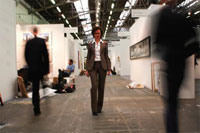 Survival of the fittest? NYC fairs multiply despite recession
Survival of the fittest? NYC fairs multiply despite recession
With a record number of concurrent events taking place during this year's Armory Show, galleries and artists are competing for attentionArmory Show executive director Katelijne De Backer hopes the fair will stand out from the crowd this week (Photo: Casey Fatchett)
Collectors have been limbering up in anticipation of the 12th annual Armory Show, which opens with 289 galleries (until 7 March). But these are not the only exhibitors vying for attention. There is a record 483 galleries and artist projects in 11 further concurrent fairs: the Art Show; Dutch Art Now; Fountain New York; Independent; Korean Art Show; PooL; Pulse; Red Dot; Scope New York; Verge New York and Volta New York. It would take 64 hours and 25 minutes to see every presentation should five minutes be spent at each. In a city that already boasts more than 600 museums, galleries and foundations, how do these fairs hope to stand out from the crowd?
“It’s American Idol for the visual arts,” said New York-based art advisor Todd Levin. “It’s like a talent show—lots of people want to appear on a New York platform. Most perform badly, but a few will rise to the top.” Is this activity a sign of renewed confidence? Or have cheap rents given cash-strapped galleries a chance for one last roll of the dice? Veteran New York estate agent Susan Anthony said that the fair boom is “fuelled by the recession impacting on the real estate market. Satellite fairs are a variation on pop-up shops with reduced rentals and quick turnaround.” PooL, which opens on 5 March with work by 85 artists in the Gershwin Hotel, has benefited: “This is the cheapest fair we’ve ever organised,” said Sadie Weis. “Artists pay $1,450 per room, compared with $1,600 in previous years at other hotels.”
The Independent is a new fair that has also taken advantage of cheap rents. It will occupy the former Dia building in Chelsea from 4 March. “Two years ago, the rent on the ground floor alone at the Dia building would have been $1m. Now that figure has dropped 40%,” said Anthony. Independent co-founder Darren Flook has teamed up with New York gallerist Elizabeth Dee to create a 30-strong presentation by European and New York galleries. The structure is unusual: exhibitors pay “$13 per sq. foot (as opposed to the usual $50-$70 per sq. foot of the average fair)” according to Flook, and share all overheads.
“It’s like going to a party where you bring your own food—you have something invested in the event being good,” said Flook, adding: “We have taken off the trimmings. There is no VIP lounge or programme—it’s just about the art.” Independent is the talk of the town thanks to a strong identity—its “rough, scruffy, underdog status”, says art advisor Stefano Basilico.
So, how are the other fairs distinguishing themselves? “Especially in this economic climate, there are enormous branding issues,” said New York-based art advisor Sharon Coplan Hurowitz, who is collaborating with branding expert Robert Burke on various art projects. “With so many fairs you have to ask, do they have a specific identity?” said Pulse director Helen Allen. Her fair is returning for a fifth year with 66 exhibitors from 19 countries. Allen says: “The Dutch and Korean fairs, Independent and Volta have their own niche, but I am not so sure about some of the others.”
The Korean Art Show is a new initiative that forms “part of a Korean invasion of New York,” according to its organiser Ken Kim. “We are bringing 100 collectors from Korea, China and Japan,” said Kim adding that: “There are no stand fees because the Korean government is subsidising the fair and leasing the building.” In contrast, the Art Show is a Park Avenue blue-chip boutique fair, now in its 22nd edition. Exhibitors are all members of the Art Dealers Association of America, and pride themselves on focused presentations of big-name artists including Robert Rauschenberg, Martin Kippenberger and William Kentridge. New York gallery Cheim & Read, for instance, are selling a Joan Mitchell painting priced at $3.5m.
Meanwhile, the biggest fair—the Armory Show—can count on sheer weight of numbers, which executive director Katelijne De Backer says makes it “unique”. She also points to the new Berlin focus (see pp1, 4) and increasing number of Lower East Side galleries in the fair, which she says “gives the fair a younger energy—we want to attract a new generation of dealers as well as retaining the big names.”
While the fairs battle for brand supremacy, 22 galleries are hedging their bets by showing at more than one fair. Tanya Bonakdar, for example, initially planned to only participate in the Art Show, but “made a late inquiry into available positions” at the Armory Show, and “was delighted to work out an arrangement to participate”, according to gallery director Ethan Sklar who added: “We felt that an outpost at the fair would allow us to promote a concurrent exhibition with Olafur Eliasson at the gallery.”
Further examples of galleries with booths at both the Art Show and the Armory Show include David Zwirner and PaceWildenstein. Other crossovers include Michael Werner, who is showing at both the Art Show and Independent, while Johann König and Andrew Kreps are exhibiting at both the Armory and Independent.
But perhaps the most successful brand of all is the city itself. “New York is special,” said Darren Flook. “It is still the art city.” This week, New York’s pulling power will be tested as the art world waits to see whether Manhattan can build on the success of the record-breaking auctions of impressionist and modern, and postwar and contemporary art held in London last month.
 Survival of the fittest? NYC fairs multiply despite recession
Survival of the fittest? NYC fairs multiply despite recession